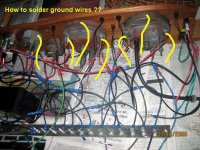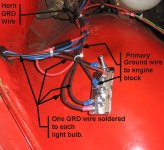T
Tinster
Guest
Guest
Offline
Another easy wiring question that escapes my
understanding or skill level.
I spent most of Friday evening attempting to solder
ground wires to the speedo and tach housings and also
solder ground wires to the small dash gauges so the
lights would light up. See Attached photo.
I sanded and steel wool cleaned the housings down to
white metal, wiped with xylol but again and again I
cannot get the copper wires and acid free solder to
stick to the metal housings. The solder melts very well
but then slides off no matter what I try.
If I scotchtape the ground wires in place; the lights
turn on when a battery current is applied. But that seems
pretty lame like a PO technique.
How does one solder all these ground wires to the dash
board gauges and lights?? A special type of solder is
required? What about if I squash the copper wire down
with a SS washer and then cover the washer with epoxy? Would that provide adequate grounding?
I have completed installation of the stainless steel
ground wire harness bars all over the car with one ground
wire per electrical connection as shown on the wiring
diagram. I am now only lacking the final ground wires for
the dash gauges. Then I think I will have 100% successfully
installed the grounding wire harness for a TR6.
Then it's onward to the color coded wires that I cannot
yet figure out. (confession time- I am bringing in a TR6
Dan Masters wire harness expert for the colored wires)
thanks as always,
understanding or skill level.
I spent most of Friday evening attempting to solder
ground wires to the speedo and tach housings and also
solder ground wires to the small dash gauges so the
lights would light up. See Attached photo.
I sanded and steel wool cleaned the housings down to
white metal, wiped with xylol but again and again I
cannot get the copper wires and acid free solder to
stick to the metal housings. The solder melts very well
but then slides off no matter what I try.
If I scotchtape the ground wires in place; the lights
turn on when a battery current is applied. But that seems
pretty lame like a PO technique.
How does one solder all these ground wires to the dash
board gauges and lights?? A special type of solder is
required? What about if I squash the copper wire down
with a SS washer and then cover the washer with epoxy? Would that provide adequate grounding?
I have completed installation of the stainless steel
ground wire harness bars all over the car with one ground
wire per electrical connection as shown on the wiring
diagram. I am now only lacking the final ground wires for
the dash gauges. Then I think I will have 100% successfully
installed the grounding wire harness for a TR6.
Then it's onward to the color coded wires that I cannot
yet figure out. (confession time- I am bringing in a TR6
Dan Masters wire harness expert for the colored wires)
thanks as always,

 Hey there Guest!
Hey there Guest!
 smilie in place of the real @
smilie in place of the real @
 Pretty Please - add it to our Events forum(s) and add to the calendar! >>
Pretty Please - add it to our Events forum(s) and add to the calendar! >> 


 A friendly reminder - be careful what links you click on here. If a link is posted by someone you don't know, or the URL looks fishy, DON'T CLICK. Spammers sometimes post links that lead to sites that can infect your computer, so be mindful what you click.
A friendly reminder - be careful what links you click on here. If a link is posted by someone you don't know, or the URL looks fishy, DON'T CLICK. Spammers sometimes post links that lead to sites that can infect your computer, so be mindful what you click.